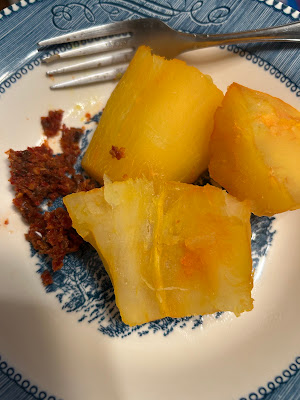 |
| Yuca/Cassava/Manioc (Manihot esculenta) |
Yuca, cassava, and manioc are only some of the commonly used names for this tuberous root that I purchased from the ethnic store on Friday. It's scientific name is Manihot esculenta. I grew up calling it manioc.
I cooked it for our brunch on Monday. Cassava has to be carefully peeled and washed before cooking because there is a poisonous layer containing cyanide just under the brown peel. Fortunately, the whole peel and the poisonous layer comes off as one rind if you cut into it and pry it off the tuber with the tip of a knife. But, if you just scrape off only the brown peel, the reddish layer under it is poisonous and must be removed.
 |
| Cassava Peel and Semi-Peeled Section |
I was showing my daughter how to remove the peel properly - you can see the rind that I peeled off in one piece at the top and a semi-peeled section just below it, where I had just scraped off the thin brown peel to reveal the reddish toxic layer containing cyanide which should be removed before cooking and eating (although, cooking will remove most of the cyanide). I peeled off the reddish layer after I took this picture.
 |
| Boiled Manioc with Lunu Miris |
I served the cooked manioc with some lunu miris, which is a mixture of dried red chilies, onions, lime juice, Maldive fish powder (a type of dried tuna), and salt. It was delicious and obviously, I cleaned it well because both my daughter and I are well and alive. LOL.
That was very interesting. I have never cooked or eaten a cassava root but I do have some cassava flour in the pantry that Theo used when he was here. I just read up on the nutrition benefits of cassava and it sounds pretty good. What is the flavor like? Does it absorb the flavors it's cooked with?
ReplyDeleteI think that it has a very mild flavor and absorbs the flavors it's cooked with. It's a bit like a starchy potato, but, with a firmer texture. If you've ever eaten tapioca, it's made with the starch from the cassava root.
DeleteYou eat the most interesting things. I'm going to move down and live with you, but it won't be for at least 4 years!!
ReplyDeleteLOL! Maybe I'll come and visit you, first, and bring my food with me! :D
DeleteFinally, something exotic that you post about that I have actually cooked. I feel like a winner!
ReplyDeleteOh, you are definitely a winner in my opinion, Anne, whether you prepare the same food or not. And you prepare some dishes that sound exotic to me, like pimento cheese (never had it!) :)
DeleteThat sounds... scarily amazing?
ReplyDeleteTo someone brought up on British food, your dinner sounds wonderfully tasty and nourishing and completely out of my experience. I've seen cassava on the supermarket sites but I've never tried it. I feel more confident now.
I also like the idea of lunu maris - it's the sort of thing that my husband would love. Thank you!
I thought you might find that bit of information to be useful in your writing, Lyssa. :) Between the arsenic in rice and cyanide in cassava, one can cook up an interesting dinner with maybe a serving of fugu (pufferfish) on the side? :D
DeleteIf you are able to find frozen, peeled cassava, that would be a good way to try it. I think your husband would like lunu miris. :)
I've never heard of this before. Is it something that is quite adaptable in cooking, if it absorbs different flavours? X
ReplyDeleteI know some people make a curry with it, but, I have always associated it with breakfast, served boiled, with grated coconut and/or a sambol like lunu miris. Cassava flour is used in many dishes, too. If you've ever had tapioca, that's made from cassava flour.
DeleteI definitely know the words cassava, yuka and tapioca, and I definitely have a feeling I don't like it/them, but I can't honestly remember why I think that, or where I might have tried it in any of its forms! I suspect some Japanese confection in the dim and distant past... If I get another opportunity I will try again and refresh my memory/satisfy my curiosity. The boiled version at the top of the post looks quite acceptable to me! :o)
ReplyDeleteYou might have had something made from the cassava flour, somewhere. I do like the boiled cassava and that's how I usually have it. Cassava curry would be good, too.
DeleteI've never heard of manioc and really enjoyed your explaining what it is and how you prepare it.
ReplyDeleteIs there anything that comes to mind you could compare the taste to?
Thank you, Debra. I had posted about it, earlier, way back in March 2017 with a few more photos than I included in this post, but, that was before you started reading my blog, I think.
DeleteI think the taste is a little similar to sweet potatoes or, maybe even yams, but, not as sweet.
If you've ever eaten tapioca, it's made from manioc/cassava flour. :)
That's very interesting. I love tapioca. I mean I really love tapioca. lol
DeleteThere you go. Now you can say you've eaten manioc in the form of tapioca! :D
Delete